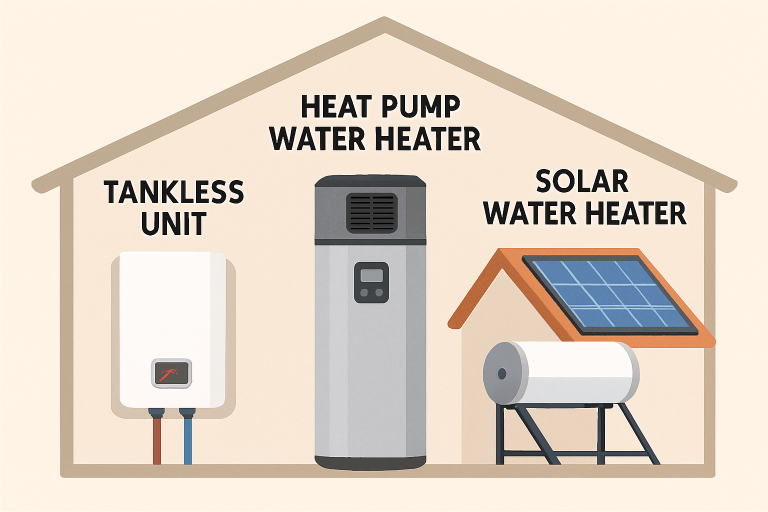Key Takeaways
- Modern water heaters are designed for improved energy efficiency and lower utility costs.
- Popular choices include tankless, heat pump, solar, and smart water heaters.
- Homeowners may qualify for valuable incentives, rebates, or tax credits on energy-efficient upgrades.
Table of Contents
- Introduction
- Tankless Water Heaters
- Heat Pump Water Heaters
- Solar Water Heaters
- Smart Water Heaters
- Incentives and Rebates
- Choosing the Right Water Heater
With rising energy costs and an increased focus on sustainability, upgrading to a modern water heater is one of the most intelligent decisions homeowners can make. Today’s innovations offer streamlined efficiency, powerful performance, and user-friendly features that enhance day-to-day comfort. Whether you’re planning a renovation or want to reduce your utility bills, it’s essential to understand your options for water heater solutions designed for contemporary living. If you’re in Florida and looking for an upgrade or repair, seeking a professional water heater service in Sarasota ensures you receive expert advice, proper installation, and long-term savings. Combining knowledgeable service with leading technology helps you achieve optimal home comfort and energy efficiency. Modern water heaters come in various energy-efficient models, including tankless systems that provide hot water on demand while minimizing waste. Many models also integrate innovative technology, allowing homeowners to monitor usage and adjust settings remotely for convenience. By making the switch, you improve your daily comfort and contribute to a more sustainable and cost-effective household.
Tankless Water Heaters
Tankless, or on-demand, water heaters are revolutionizing how households access hot water. Instead of storing heated water in a tank, these systems only activate when you turn on the tap. This means no energy is wasted keeping water hot while not in use, sharply reducing standby losses that plague traditional units. An appropriately sized tankless system gives you a steady hot water supply, making it ideal for families with diverse and unpredictable water needs. Tankless models are typically wall-mounted and take up far less space than their tanked counterparts, making them perfect for modern, clutter-free homes. According to the U.S. Department of Energy, families that use less than 41 gallons of hot water daily can achieve 24–34% greater energy efficiency with tankless water heaters than traditional storage tank water heaters.
Heat Pump Water Heaters
Heat pump water heaters (HPWHs) offer another leap forward in efficiency by moving heat from the surrounding environment into the water tank, rather than directly generating heat. Operating much like a refrigerator in reverse, HPWHs can be up to three times more efficient than standard electric water heaters. They are best suited for mild to warm climates or areas in the home that tend to remain warm year-round, such as utility rooms or adjacent to a furnace. Although they have a higher upfront cost than conventional heaters, the energy savings from a heat pump system mean most homeowners see a return on their investment in just a few years. Additional benefits include lower greenhouse gas emissions and potential eligibility for state and federal energy efficiency rebates.
Solar Water Heaters
Solar water heating solutions harness the sun's power, providing an eco-friendly and affordable alternative for homes in sunny regions. These systems typically use rooftop solar collectors and a well-insulated storage tank, significantly reducing water heating bills. The environmental benefits are particularly striking—solar water heaters reduce your carbon footprint and dependence on fossil fuels. While the installation costs can be higher, various government incentives can help offset the initial investment, and the long-term savings are substantial.

Smart Water Heaters
The latest generation of water heaters comes with innovative technology, allowing homeowners to control systems remotely through smartphone apps. With the ability to program schedules, adjust temperature settings, and receive maintenance alerts, smart water heaters offer a new level of user convenience. Some models even integrate with home automation systems for seamless energy management. The result is an optimized balance between comfort, savings, and maintenance, reducing power consumption and unexpected breakdowns.
Incentives and Rebates
Federal, state, and local programs are making switching to energy-efficient water heaters easier than ever. For instance, San Francisco residents can get up to $1,200 in bill credits for switching to qualifying efficient water heaters. Federal tax credits also help offset costs for approved upgrades, including modern electric or gas water heaters and solar models. To find the incentives available in your region, the ENERGY STAR® website provides an updated list of eligible tax credits and rebates.
Choosing the Right Water Heater
Selecting the right water heating solution starts with evaluating your household’s needs and priorities. Here are several considerations:
- Hot Water Demand: Estimate how much hot water your household uses during peak times to select the right capacity and style.
- Energy Efficiency: Look for ENERGY STAR® models and compare efficiency ratings.
- Budget: Consider the upfront purchase and installation costs and projected long-term energy savings.
- Space Availability: Ensure your chosen system fits within your designated utility area or mechanical closet.
- Environmental Impact: Choose systems that reduce emissions and use renewable or recovered energy sources when possible.
You’ll enjoy years of reliable hot water, reduced utility bills, and a more environmentally friendly household by carefully matching your home's requirements to the various options available.



No comments:
Post a Comment
I love reading and responding to comments but in order to get my reply you must ensure you are NOT a no-reply blogger. If you are, here are some quick steps to change that!
1. Go to the home page of your Blogger account.
2. Select the drop down beside your name on the top right corner and choose Blogger Profile.
3. Select Edit Profile at the top right.
4. Select the Show My Email Address box.
5. Hit Save Profile.